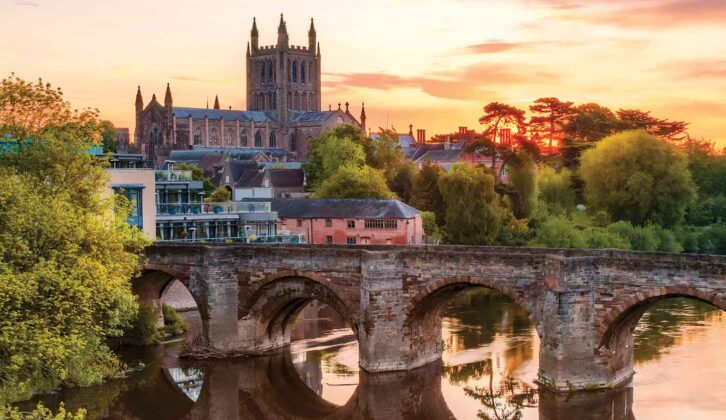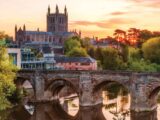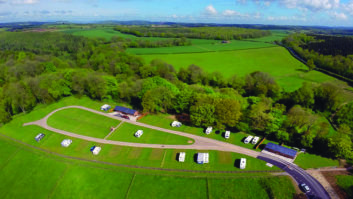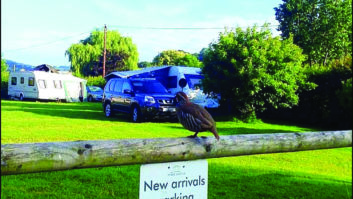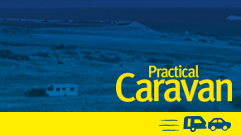Planning our itinerary for a tour in a historic and scenic part of the world, I decided to head towards Hereford on the cross-country route from our base in North Wales – not the best decision I have made.
Although much of the route was fine, we found the section between Newtown and Hereford was along winding roads, with nowhere suitable to stop for a break.
However, we made it to our campsite in reasonable time and after exploring the facilities at Poston Mill Touring Park, we decided to have a refreshing drink in The Mill Restaurant, on the site.
As well as being in just the right place for what we had planned during our visit, Poston Mill Touring Park has a bus stop right outside, meaning we could set up and then let the bus take the strain.
This is a very well-maintained site, featuring in Practical Caravan’s Top 100 Sites Guide 2023 where the best caravan parks are revealed.
It has clean facilities and is also a dog friendly caravan park. We did have one problem, though, as the height of the grey-waste receptacles meant we rather struggled to use them, because of the weight of the container. Our only option was to walk the length of the site to use the motorhome service point.
Historic Hereford
The following day, we caught the bus into Hereford, alighting in Broad Street. As we entered the city, we crossed Wye Bridge.
This Grade I listed, five-span stone bridge was built in 1490, to replace the timber bridge that dated back to the 12th century. During the 1645 Siege of Hereford in the English Civil War, the bridge was the scene of heavy fighting between Royalists and the Scottish Covenanter forces.
A gatehouse that stood at one end of the bridge was damaged and later demolished. The bridge itself was rebuilt during the 17th century and then widened in 1826.
It remained the major crossing point for the River Wye until a modern bridge was built on the A46 to the west.
The weather was glorious, so we began by going onto the bridge to take photos of the great cathedral, then stopped for coffee at De Koffie Pot, a popular café with outdoor seating and views of Wye Bridge.
The Chained Library
Suitably refreshed, we headed for the magnificent cathedral, which is famous, among other things, for housing the Mappa Mundi and the Chained Library.
The Mappa Mundi is a medieval map of the known world, dating from 1300. It is believed the map originated in Yorkshire or Lincolnshire, before being taken to Hereford Cathedral, where it has remained ever since.
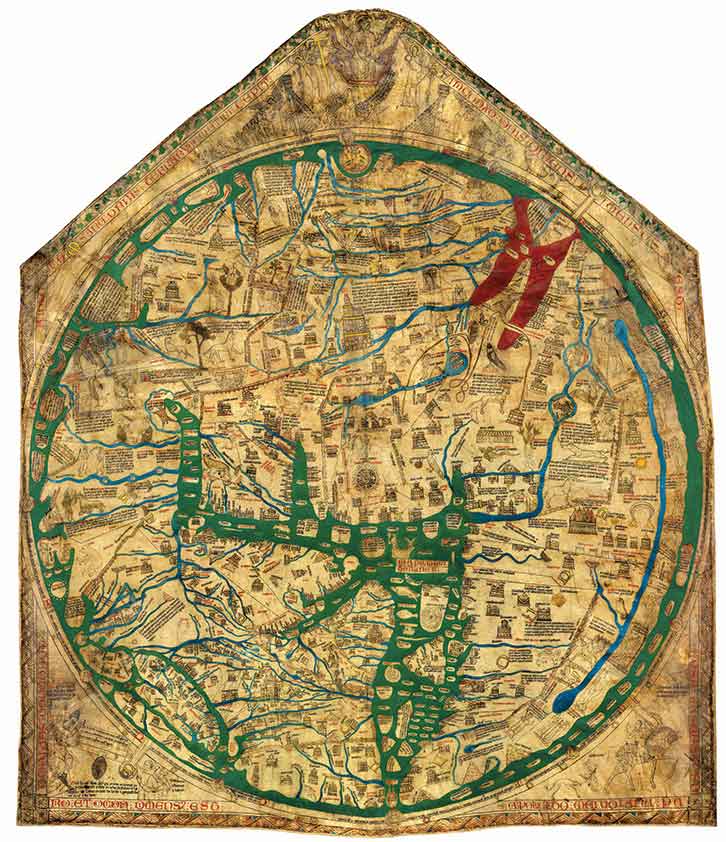
A unique document, the map portrays Jerusalem as the centre of the world, with the British Isles at the bottom on the left.
The cathedral’s Chained Library has an equally rich heritage, storing its hugely valuable volumes in what was an effective security system, in use from the Middle Ages. Hereford’s Chained Library, dating from the 17th century, is the largest to survive with all of its chains, rods and locks intact.
A chain was attached to one end of each book’s cover, with the other end slotted on to a rod along the bottom of the shelf. This allowed the books to be taken from the shelf and read at a desk, but not to be removed from the bookcase.
Cultural city life
We continued strolling around the area, window shopping and taking in the sights. Hereford is relatively easy to negotiate, the centre being pedestrianised, which was a particularly welcome discovery.
It also hosts a number of fine museums, the first of which we came across in Broad Street. The Hereford Museum and Art Gallery, in a splendid Victorian Gothic building, has been exhibiting artifacts and works of fine and decorative art connected with the local area since 1874.
We made our way to High Town, which is pedestrianised and has a number of food outlets, just some of the wide choice of cafés and restaurants catering for this diverse city.
At the far end, we found the Black and White House Museum, a well-preserved example of a 17th-century timber-framed building, which has housed a museum since 1929. There are exhibits giving an insight into daily life during Jacobean times, and it is furnished in period style, with a collection of English oak furniture. There are also rare wall paintings, and a fine four-poster bed. It has three floors to explore, with a virtual tour on the ground floor, as well as Braille and tactile images for the visually impaired. Children will enjoy the lively hands-on activities.
Thirsty work
Visitors to Hereford are spoilt for choice, it has so many attractions. Two that we found especially interesting were the Museum of Cider, where you can learn how apples are pressed and milled and how the resulting juice was fermented to produce cider, a centuries-old tradition still in practice today, and the Waterworks Museum, which tells the story of drinking water.
In this fascinating industrial museum, you can see the UK’s widest range of working pumps and engines from the local area, most of which are the last remaining functional examples of their type.
There is something for the children here, too, with hands-on exhibits, including the Heritage Water Park.
Time for a tea shop
Looking for somewhere to stop and have lunch, we needed to choose from the many tempting eateries. We opted for The Antique Tea Shop in St Peter’s Street, which was an excellent choice. This family-run café had a good selection of snacks and cakes.
Later on, we headed for Castle Green, a charming park where there is a monument to Lord Nelson, who was made a freeman of the city in 1802.
The column was built in 1809, four years after Nelson’s death, but there were insufficient funds to add the planned statue of the great man, so a small sculpture of a memorial urn was placed there instead.
From here, we walked to Victoria Bridge, a wrought-iron suspension bridge linking the north bank of the Wye with Bishop’s Meadow on the south side.
Opened in 1898 and replacing an earlier ferry service across the river, the footbridge is now Grade II listed. It was beautifully restored by Hereford Council in 2006.
Crossing the Victoria Bridge, we headed back to the Wye Bridge along the riverside walk, enjoying excellent views of Hereford Cathedral across the river. As there was a while before we needed to catch the bus back to the campsite, we returned to the cathedral, where we bought tea at the Cathedral Café and carried our cups outside to sit in the sun in the peaceful Cloister Gardens, for a welcome rest after all that exploring.
Hay Castle
The next day dawned with more sunshine, so we caught the bus from the site in the other direction, to Hay-on-Wye. This charming place is known as ‘the town of books’ because of its many bookshops, although the number of specialist bookshops has greatly reduced, with many of them now antique shops.
We got off the bus at the Castle stop and headed for the recently opened Hay Castle, a medieval fortification and fine 17th-century mansion house. It was constructed originally as part of the Norman invasion of Wales, built as a ringwork overlooking the town in the late 11th or early 12th century.
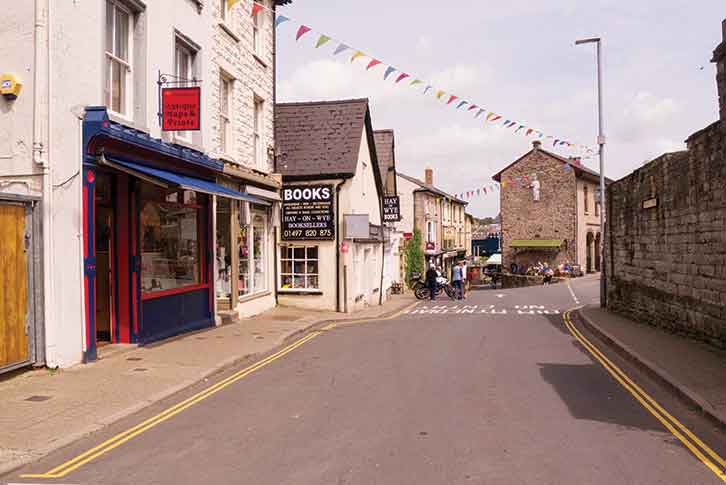
Ringwork castles had a relatively simple design, with a roughly circular earthwork bank surrounded by a protective ditch, and timber ramparts on top. It was rebuilt in stone around 1200 by the de Braose family.
In 2000, both castle and manor were in need of restoration, the Norman keep being unstable, the archway impassable, and the east wing of the Jacobean manor roofless and derelict. The property was acquired by the Hay Castle Charity Trust, which raised funds to restore the building. A grant from the National Lottery Heritage Fund and matched funding allowed work to begin in 2018 (with Covid adding to the delays). Splendidly restored, Hay Castle was finally opened to the public in May 2022.
The Cheese Market
Having paused for a coffee at the castle’s café, we strolled through the archway and took the steps down to Castle Street, where we found a huge variety of bookshops and independent shops to browse.
We wandered around the narrow streets of this bustling market town, exploring among books and antiques until lunchtime. For lunch, we stopped at The Cosy Café, where they serve excellent crepes.
Close to the café is the historic Cheese Market, another restoration project partly financed by the National Lottery Heritage Fund. This elegant building, formerly the Town Hall, is now Grade II listed.
Built in 1835 by Sir Joseph Bailey as a manorial courtroom with a market hall below, it occupies a prominent position in the centre of the town.
Over the years, the building has served various purposes, including a furniture showroom, a Masonic Lodge, a school hall and a Roman Catholic church, as well as hosting social events, such as dances and even ventriloquist shows.
The structure became rather run down with the passage of time and in 2008, Powys County Council decided to sell it.
A Community Interest Company bought it, with a plan to restore the Cheese Market, and the refurbished building reopened in 2014, with space for local market traders.
Golden Valley
On our final full day in the area, we decided to walk a section of the Herefordshire Trail, a long-distance path that loops around the county and is accessible from Poston Mill.
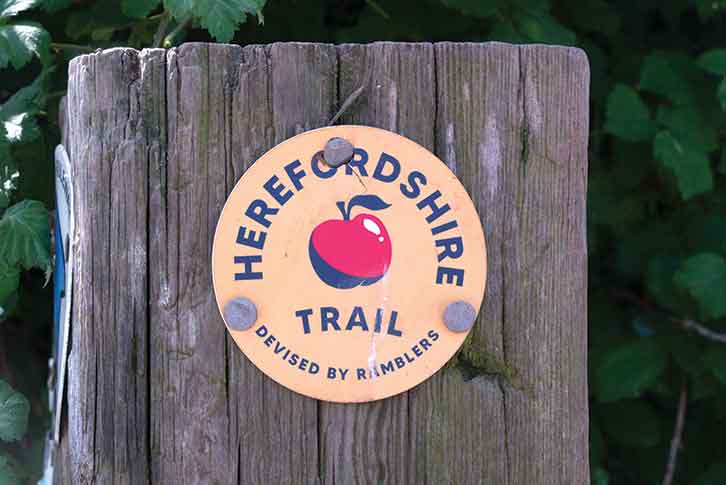
Stretching for 154 miles, the path links five of Herefordshire’s main market towns, offering a good choice of steep climbs and wooded river valley trails, or gentler strolls through hopyards and orchards, passing historic landmarks such as ancient hillforts, castle ruins and remote churches.
We decided to follow the two-mile route to the pretty village of Peterchurch, along the Golden Valley. Although this is just a small section of the whole trail, it was very scenic. We walked along a wooded river valley, through fields covered in buttercups, yellow as far as the eye could see (check out our guide to our pick of the top sites for canal and river walks if you’d like to see more like this).
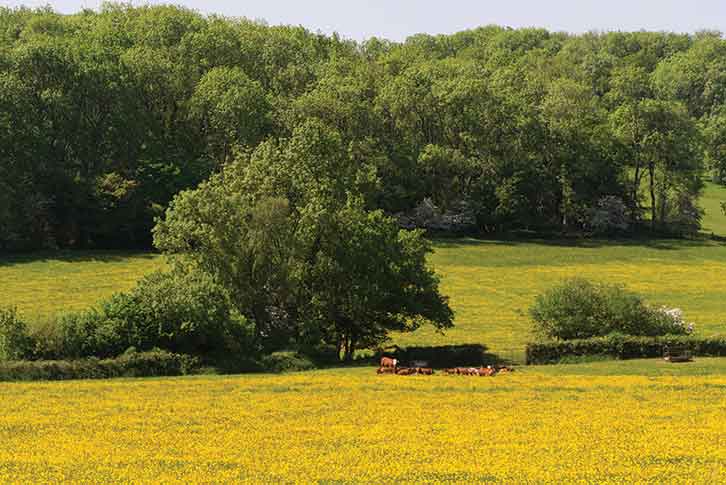
Soon the tall steeple of St Peter’s Church came into view, and we knew that we were approaching the village. Turning off the footpath, we walked along the main road towards the village centre and spotted a sign for a community hub with a café. Unfortunately, the sign didn’t say where it was located, but we were soon pointed towards the church by a helpful local.
The Hub seeks to provide residents of the Golden Valley with a place to meet and socialise, as well as offering wellbeing support and advice about local services.
The café is open from Wednesday to Saturday, and we were lucky as we visited on a Wednesday, so we made this our stop for morning coffee and later returned for lunch. It’s a wonderfully inclusive use of a church, and we were delighted to be able to support the project in a small way.
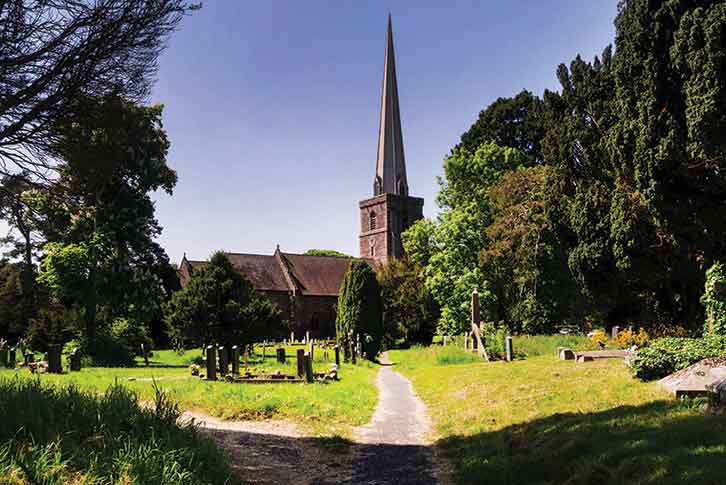
Honoured for valour
Pausing outside the church, we noticed a sign pointing to the grave of Private Robert Jones (1857-1898), which we found along the path in the churchyard.
Private Jones was awarded the VC for his bravery in the 1879 Battle of Rorke’s Drift, during the Zulu War. Stationed in a hospital ward, he and a fellow soldier kept up heavy fire against the enemy, managing to carry six patients to safety.
One man refused to be moved, and when Private Jones returned to rescue him, he was seriously wounded. He later received the Victoria Cross, one of the highest awards a British soldier can receive.
When he returned home, Private Jones married and had five children, but sadly, in 1898 he died from gunshot wounds to the head. His death was recorded as suicide – he had suffered recurring nightmares arising from the conflict.
The suicide verdict meant that his coffin was not allowed to be carried through the church gates, so it had to be lifted over the wall instead, and his headstone is the only one facing away from the church. No doubt today, he would have been diagnosed as suffering from PTSD.
It was a touching end to our tour of this fascinating area; one that we are sure we’ll return to in future.
You may also like:
- Find out how Elaine and Joe Ormerod got on when they set off on a tour to Newark and the surrounding area, discovering the turbulent history of the area.
Planning a trip to Hereford
From North Wales, we headed for Shrewsbury to pick up the A49. Driving through Hereford, we set course for Abergavenny and picked up the B4349 and the B4348. Poston Mill Touring Park is approximately 12 miles south of Hereford.
Interested in exploring Wales instead? Then check out our guide to the best caravan parks in Wales to see our top picks to stay at.
Find out more
- Hereford Tourist Information
- Hay-on-Wye Tourist Information
- Hereford Cathedral
- Mappa Mundi and the Chained Library
- The Herefordshire Trail
- The Hub at St Peter’s
Lead image: Getty Images
If you’ve enjoyed reading this article, why not get the latest news, reviews and features delivered direct to your door or inbox every month. Take advantage of our brilliant Practical Caravan magazine SUBSCRIBERS’ OFFER and SIGN UP TO OUR NEWSLETTER for regular weekly updates on all things caravan related.
